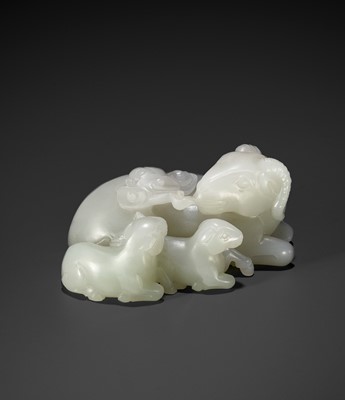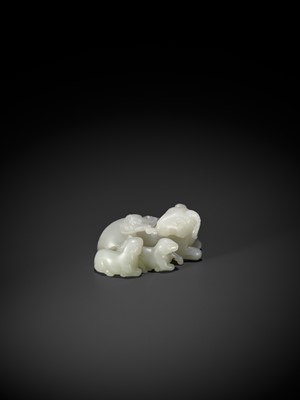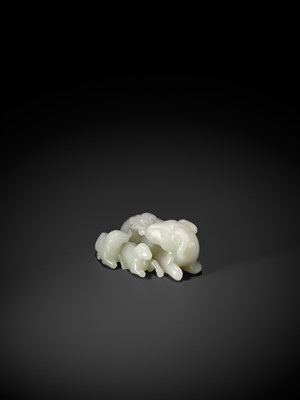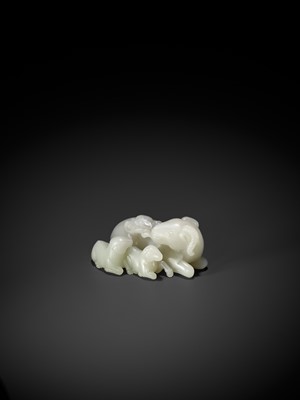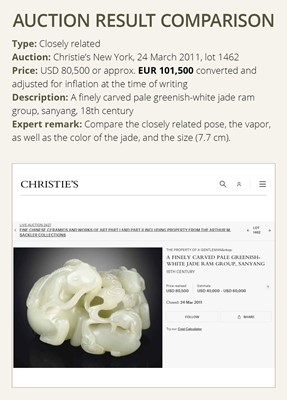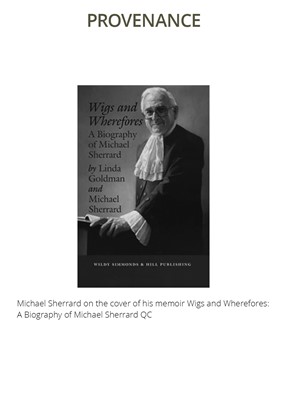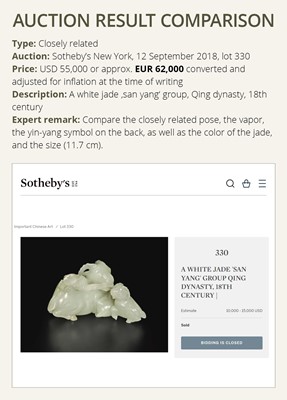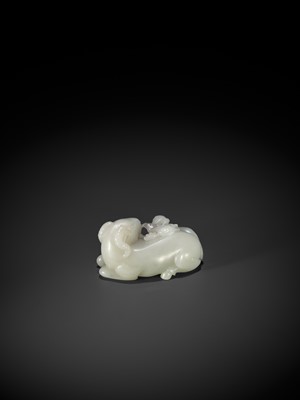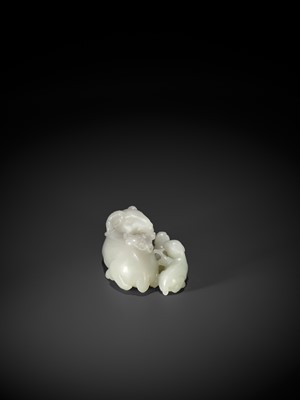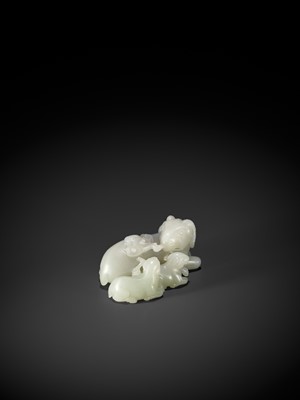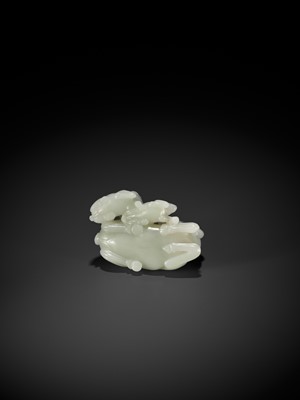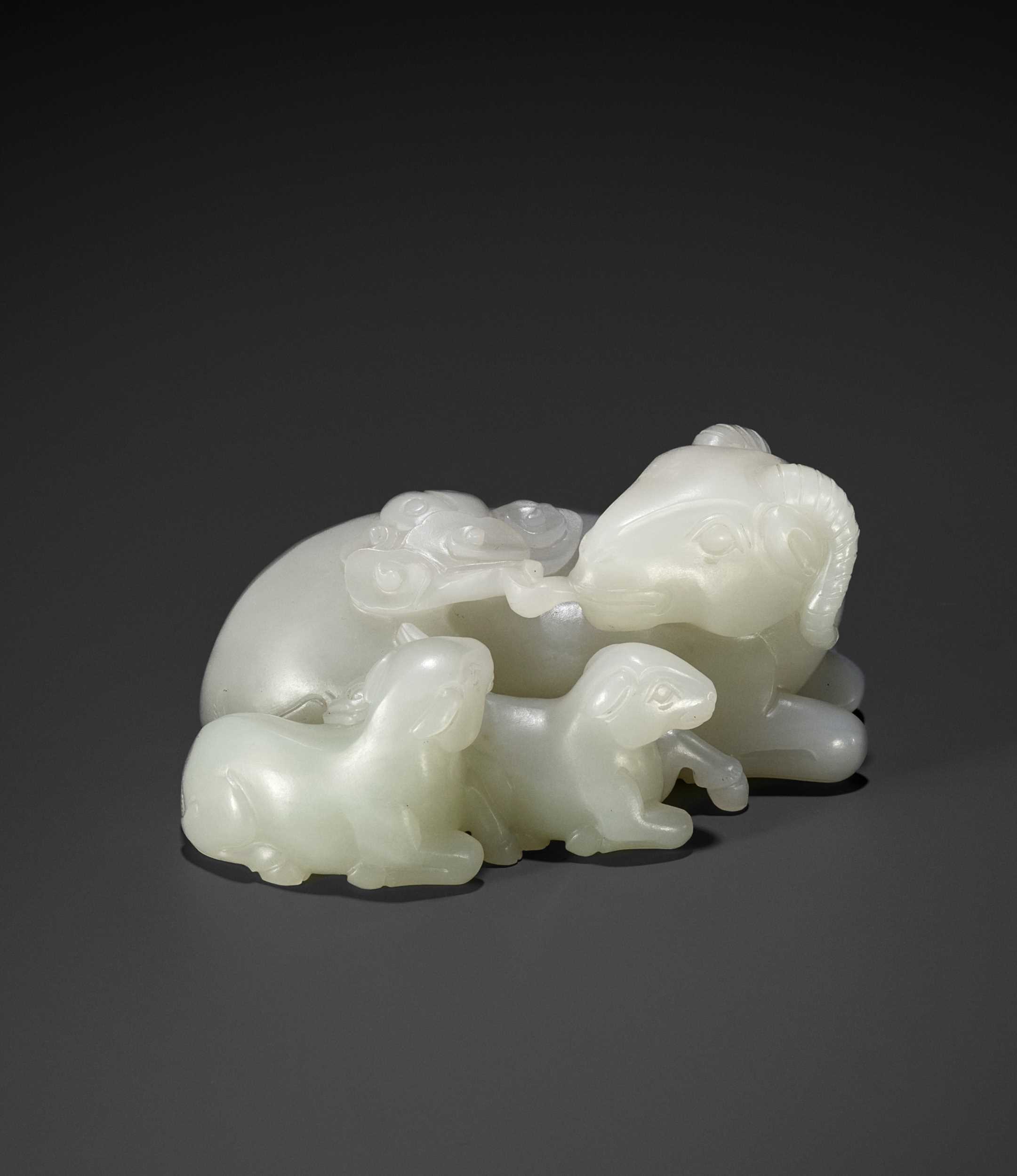29th Sep, 2022 13:00
DAY 1 - TWO-DAY AUCTION - Fine Chinese Art / 中國藝術集珍 / Buddhism & Hinduism
56
A RARE PALE CELADON JADE ‘SANYANG AND TAIJITU’ GROUP, 18TH CENTURY
十八世紀罕見青白玉三羊開泰擺件
Sold for €5,200
including Buyer's Premium
China. Carved as three recumbent rams, the larger animal with its head turned to the right, two smaller rams nestled at its side, each with wisps of vapor billowing from the mouths, with fine hair markings on the edge of the tails. The larger ram with a taijitu symbol emerging from its vapor. The translucent stone of an even pale celadon tone.
Provenance: From the collection of the late Michael Sherrard CBE, QC, acquired before 2000 and thence by descent. Michael Sherrard (1928-2012) was an English barrister in fraud and company law who was considered one of the great recent influences on the legal profession. He was involved in numerous high-profile cases in both English and East Asian courts, particularly Hong Kong and Singapore. Together with Linda Goldman, he wrote a memoir titled “Wigs and Wherefores: A Biography of Michael Sherrard QC”. Sherrard was an enthusiastic collector of Chinese art, especially jade carvings.
Condition: Excellent condition with minor wear, a fine natural fissure to the larger ram’s head, and possibly microscopic nicks here and there. The stone with an attractive soft polish.
Weight: 353.5 g
Dimensions: Length 10.2 cm
The ram is a symbol of filial piety, kindness, and patience. The three rams, san yang, are also an auspicious motif, related both to the sun and to male children, as they provide a rebus for san yang kai tai, the opening up of the new growth in spring, which in turn symbolizes happiness and good fortune. Furthermore, the motif of three goats with the taijitu symbol suggests the auspicious beginning of a new year, based on a quotation from the I Ching (Yijing or Book of Changes).
A taijitu is a symbol or diagram in Chinese philosophy representing Taiji, the "utmost extreme", in both its monist (wuji) and its dualist (yin and yang) aspects. Such a diagram was first introduced by Song dynasty philosopher Zhou Dunyi (1017–1073) in his Taijitu shuo. The modern Taoist canon, compiled during the Ming era, has at least half a dozen variants of such taijitu. The two most similar are the "Taiji Primal Heaven" (tàijí xiāntiān tú) and the "wuji" (wújí tú) diagrams, both of which have been extensively studied during the Qing period for their possible connection with Zhou Dunyi's taijitu.
Literature comparison:
Compare with three jade groups of the three rams in the Palace Museum, Beijing, one illustrated in Jadeware (III), The Complete Collection of Treasures of the Palace Museum, Hong Kong, 1995, pl. 88 (fig. 1). Compare two groups illustrated in Zhongguo Yuqi Quanji, vol. 6, pls. 269 and 307. Compare also one jade group of rams in the Tianjin Municipal Museum, illustrated in Cang Yu, Hong Kong, 1993, pl. 216.
Auction result comparison:
Type: Closely related
Auction: Christie’s New York, 24 March 2011, lot 1462
Price: USD 80,500 or approx. EUR 101,500 converted and adjusted for inflation at the time of writing
Description: A finely carved pale greenish-white jade ram group, sanyang, 18th century
Expert remark: Compare the closely related pose, the vapor, as well as the color of the jade, and the size (7.7 cm).
Auction result comparison:
Type: Closely related
Auction: Sotheby’s New York, 12 September 2018, lot 330
Price: USD 55,000 or approx. EUR 62,000 converted and adjusted for inflation at the time of writing
Description: A white jade 'san yang' group, Qing dynasty, 18th century
Expert remark: Compare the closely related pose, the vapor, the yin-yang symbol on the back, as well as the color of the jade, and the size (11.7 cm).
十八世紀罕見青白玉三羊開泰擺件
中國。青白玉圓雕三羊,趴伏於地,昂首擺尾,神態溫順。大羊口中叼著一株靈芝。玉質堅實,光澤柔美,刀法細膩,打磨精緻圓潤。
來源:Michael Sherrard CBE,QC 收藏,於 2000 年之前購買,保存至今。Michael Sherrard (1928-2012年) 是一名英國大律師,被認為是近期對法律界產生重大影響的人物之一。 他在英國和東亞法院,尤其是香港和新加坡,參與了多起著名案件。 他與Linda Goldman一起寫了一本回憶錄,題為《Wigs and Wherefores: A Biography of Michael Sherrard QC》。 Sherrard 是一位熱心的中國藝術品收藏家,尤其喜愛玉雕。
品相:狀況良好,輕微磨損,公羊頭部有細密的天然裂縫,有微小的刻痕。
重量:353.5 克
尺寸:長10.2 厘米
“羊”與“祥”相通,而“美”、“善”兩字皆創造自羊之形意,因此羊又被稱作“吉羊”,古人以羊作飾,多寄託吉祥美好之願景。明清文玩擺件,喜繪“三陽開泰”紋樣。《易经》云:“十月为坤卦,纯阴之象。十一月为复卦,一阳生於下。十二月为临卦,二阳在下。下月为泰卦,三阳大下”。以“羊”喻“陽”,寓意春回大地,萬象更新。
文獻比較:
比較三陽開泰三件玉組,收藏於北京故宮博物院,一件見 《故宫博物院藏文物珍品全集‧玉器》,香港,1995年,編號88 (圖1)。比較兩件玉組, 見《中國玉器全集》,卷六,編號269和307。比較一件玉雕羊,收藏於天津博物館,見
《Cang Yu》,香港,1993年,編號216。
拍賣結果比較:
形制:非常相近
拍賣:紐約佳士得,2011年3月24日,lot 1462
價格:USD 80,500(相當於今日EUR 101,500)
描述:十八世紀青白玉三羊開泰擺件
專家評論:比較非常相近的姿勢、玉石顏色,以及尺寸 (7.7 厘米)。
拍賣結果比較:
形制:非常相近
拍賣:紐約蘇富比,2018年9月12日,lot 330
價格:USD 55,000(相當於今日EUR 62,000)
描述:清十八世紀白玉雕三羊開泰擺件
專家評論:比較非常相近的姿勢、背上陰陽標誌,以及玉石顏色和尺寸 (11.7 厘米)。
China. Carved as three recumbent rams, the larger animal with its head turned to the right, two smaller rams nestled at its side, each with wisps of vapor billowing from the mouths, with fine hair markings on the edge of the tails. The larger ram with a taijitu symbol emerging from its vapor. The translucent stone of an even pale celadon tone.
Provenance: From the collection of the late Michael Sherrard CBE, QC, acquired before 2000 and thence by descent. Michael Sherrard (1928-2012) was an English barrister in fraud and company law who was considered one of the great recent influences on the legal profession. He was involved in numerous high-profile cases in both English and East Asian courts, particularly Hong Kong and Singapore. Together with Linda Goldman, he wrote a memoir titled “Wigs and Wherefores: A Biography of Michael Sherrard QC”. Sherrard was an enthusiastic collector of Chinese art, especially jade carvings.
Condition: Excellent condition with minor wear, a fine natural fissure to the larger ram’s head, and possibly microscopic nicks here and there. The stone with an attractive soft polish.
Weight: 353.5 g
Dimensions: Length 10.2 cm
The ram is a symbol of filial piety, kindness, and patience. The three rams, san yang, are also an auspicious motif, related both to the sun and to male children, as they provide a rebus for san yang kai tai, the opening up of the new growth in spring, which in turn symbolizes happiness and good fortune. Furthermore, the motif of three goats with the taijitu symbol suggests the auspicious beginning of a new year, based on a quotation from the I Ching (Yijing or Book of Changes).
A taijitu is a symbol or diagram in Chinese philosophy representing Taiji, the "utmost extreme", in both its monist (wuji) and its dualist (yin and yang) aspects. Such a diagram was first introduced by Song dynasty philosopher Zhou Dunyi (1017–1073) in his Taijitu shuo. The modern Taoist canon, compiled during the Ming era, has at least half a dozen variants of such taijitu. The two most similar are the "Taiji Primal Heaven" (tàijí xiāntiān tú) and the "wuji" (wújí tú) diagrams, both of which have been extensively studied during the Qing period for their possible connection with Zhou Dunyi's taijitu.
Literature comparison:
Compare with three jade groups of the three rams in the Palace Museum, Beijing, one illustrated in Jadeware (III), The Complete Collection of Treasures of the Palace Museum, Hong Kong, 1995, pl. 88 (fig. 1). Compare two groups illustrated in Zhongguo Yuqi Quanji, vol. 6, pls. 269 and 307. Compare also one jade group of rams in the Tianjin Municipal Museum, illustrated in Cang Yu, Hong Kong, 1993, pl. 216.
Auction result comparison:
Type: Closely related
Auction: Christie’s New York, 24 March 2011, lot 1462
Price: USD 80,500 or approx. EUR 101,500 converted and adjusted for inflation at the time of writing
Description: A finely carved pale greenish-white jade ram group, sanyang, 18th century
Expert remark: Compare the closely related pose, the vapor, as well as the color of the jade, and the size (7.7 cm).
Auction result comparison:
Type: Closely related
Auction: Sotheby’s New York, 12 September 2018, lot 330
Price: USD 55,000 or approx. EUR 62,000 converted and adjusted for inflation at the time of writing
Description: A white jade 'san yang' group, Qing dynasty, 18th century
Expert remark: Compare the closely related pose, the vapor, the yin-yang symbol on the back, as well as the color of the jade, and the size (11.7 cm).
十八世紀罕見青白玉三羊開泰擺件
中國。青白玉圓雕三羊,趴伏於地,昂首擺尾,神態溫順。大羊口中叼著一株靈芝。玉質堅實,光澤柔美,刀法細膩,打磨精緻圓潤。
來源:Michael Sherrard CBE,QC 收藏,於 2000 年之前購買,保存至今。Michael Sherrard (1928-2012年) 是一名英國大律師,被認為是近期對法律界產生重大影響的人物之一。 他在英國和東亞法院,尤其是香港和新加坡,參與了多起著名案件。 他與Linda Goldman一起寫了一本回憶錄,題為《Wigs and Wherefores: A Biography of Michael Sherrard QC》。 Sherrard 是一位熱心的中國藝術品收藏家,尤其喜愛玉雕。
品相:狀況良好,輕微磨損,公羊頭部有細密的天然裂縫,有微小的刻痕。
重量:353.5 克
尺寸:長10.2 厘米
“羊”與“祥”相通,而“美”、“善”兩字皆創造自羊之形意,因此羊又被稱作“吉羊”,古人以羊作飾,多寄託吉祥美好之願景。明清文玩擺件,喜繪“三陽開泰”紋樣。《易经》云:“十月为坤卦,纯阴之象。十一月为复卦,一阳生於下。十二月为临卦,二阳在下。下月为泰卦,三阳大下”。以“羊”喻“陽”,寓意春回大地,萬象更新。
文獻比較:
比較三陽開泰三件玉組,收藏於北京故宮博物院,一件見 《故宫博物院藏文物珍品全集‧玉器》,香港,1995年,編號88 (圖1)。比較兩件玉組, 見《中國玉器全集》,卷六,編號269和307。比較一件玉雕羊,收藏於天津博物館,見
《Cang Yu》,香港,1993年,編號216。
拍賣結果比較:
形制:非常相近
拍賣:紐約佳士得,2011年3月24日,lot 1462
價格:USD 80,500(相當於今日EUR 101,500)
描述:十八世紀青白玉三羊開泰擺件
專家評論:比較非常相近的姿勢、玉石顏色,以及尺寸 (7.7 厘米)。
拍賣結果比較:
形制:非常相近
拍賣:紐約蘇富比,2018年9月12日,lot 330
價格:USD 55,000(相當於今日EUR 62,000)
描述:清十八世紀白玉雕三羊開泰擺件
專家評論:比較非常相近的姿勢、背上陰陽標誌,以及玉石顏色和尺寸 (11.7 厘米)。
Zacke Live Online Bidding
Our online bidding platform makes it easier than ever to bid in our auctions! When you bid through our website, you can take advantage of our premium buyer's terms without incurring any additional online bidding surcharges.
To bid live online, you'll need to create an online account. Once your account is created and your identity is verified, you can register to bid in an auction up to 12 hours before the auction begins.
Intended Spend and Bid Limits
When you register to bid in an online auction, you will need to share your intended maximum spending budget for the auction. We will then review your intended spend and set a bid limit for you. Once you have pre-registered for a live online auction, you can see your intended spend and bid limit by going to 'Account Settings' and clicking on 'Live Bidding Registrations'.
Your bid limit will be the maximum amount you can bid during the auction. Your bid limit is for the hammer price and is not affected by the buyer’s premium and VAT. For example, if you have a bid limit of €1,000 and place two winning bids for €300 and €200, then you will only be able to bid €500 for the rest of the auction. If you try to place a bid that is higher than €500, you will not be able to do so.
Online Absentee and Telephone Bids
You can now leave absentee and telephone bids on our website!
Absentee Bidding
Once you've created an account and your identity is verified, you can leave your absentee bid directly on the lot page. We will contact you when your bids have been confirmed.
Telephone Bidding
Once you've created an account and your identity is verified, you can leave telephone bids online. We will contact you when your bids have been confirmed.
Classic Absentee and Telephone Bidding Form
You can still submit absentee and telephone bids by email or fax if you prefer. Simply fill out the Absentee Bidding/Telephone bidding form and return it to us by email at office@zacke.at or by fax at +43 (1) 532 04 52 20. You can download the PDF from our Upcoming Auctions page.
How-To Guides
How to Create Your Personal Zacke Account
How to Register to Bid on Zacke Live
How to Leave Absentee Bids Online
How to Leave Telephone Bids Online
中文版本的操作指南
创建新账号
注册Zacke Live在线直播竞拍(免平台费)
缺席投标和电话投标
Third-Party Bidding
We partner with best-in-class third-party partners to make it easy for you to bid online in the channel of your choice. Please note that if you bid with one of our third-party online partners, then there will be a live bidding surcharge on top of your final purchase price. You can find all of our fees here. Here's a full list of our third-party partners:
- 51 Bid Live
- EpaiLive
- ArtFoxLive
- Invaluable
- LiveAuctioneers
- the-saleroom
- lot-tissimo
- Drouot
Please note that we place different auctions on different platforms. For example, in general, we only place Chinese art auctions on 51 Bid Live.
Bidding in Person
You must register to bid in person and will be assigned a paddle at the auction. Please contact us at office@zacke.at or +43 (1) 532 04 52 for the latest local health and safety guidelines.
